ECUADOR
Plants and Animals

Plants and Animals
Cities in ECUADOR
| Quito |
Popular destinations ECUADOR
| Galapagos islands |
Plants and Animals
Plants
Due to the different climate zones, there are also big differences in the plant and animal world. For example, Ecuador has about 25,000 species of plants and flowers, while the whole of North America has "only" 17,000 species. And new species are discovered every year. In addition, approximately 1,500 species of birds have been counted, twice as many as in North America, Europe or Australia. It is very likely that the Ecuadorian jungle contains birds that have never been seen by humans.
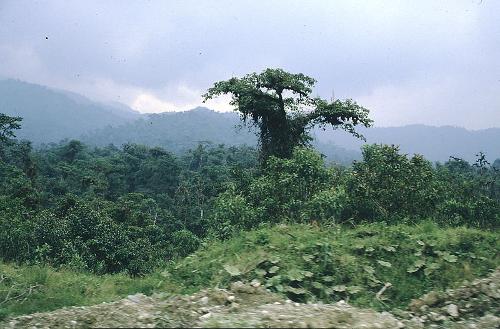 Rainforest EcuadorPhoto: Hubertl CC 3.0 Unported no changes made
Rainforest EcuadorPhoto: Hubertl CC 3.0 Unported no changes made
The tropical rainforest is divided into two areas, east of the Andes and in the northern coastal area. The rainforest is famous for its species richness and, for example, over 300 different tree species grow on one hectare. The rainforest consists of 90% "terra firma", the subsoil of which always remains practically dry and therefore hardly any low vegetation occurs. The trees, which almost all have a length of 30-40 meters, are often hundreds of years old;the roof of crowns ensures that almost no sunlight penetrates to the bottom. Common tree species are palms and bay trees. There are also terra firma forests with impenetrable low vegetation. These are reclaimed areas of land where trees only grew again at a later stage.
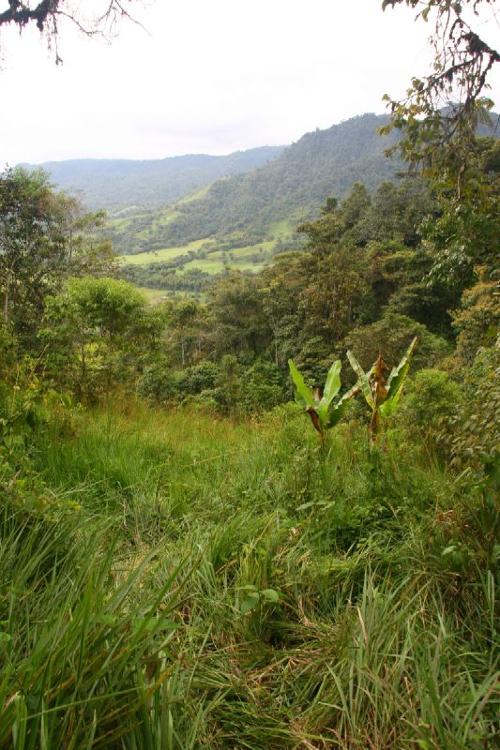 Cloud forest EcuadorPhoto: GreenockBeejamin CC 3.0 Unported no changes made
Cloud forest EcuadorPhoto: GreenockBeejamin CC 3.0 Unported no changes made
Approximately 10% of the rainforest consists of flood forests or igapóforest. After flooding, these forests are under water for an average of four to seven months, sometimes eleven months. Typical of the trees in the flood forests are the aerial roots that grow from the trunks and the water-repellent coating on the leaves. As a result, the trees survive the time they are under water. The rubber tree, which used to be of great economic importance, now only grows in the flood forests. The giants of the rainforest, the kapok trees with their gigantic supporting roots, grow on the border of the flood forests and the terra firma. The branches of the crown can reach almost twenty meters. When the water has drained, many types of ferns, shrubs, orchids, bromeliads and many other ornamental plants appear on the bottom in a short time.
Animals
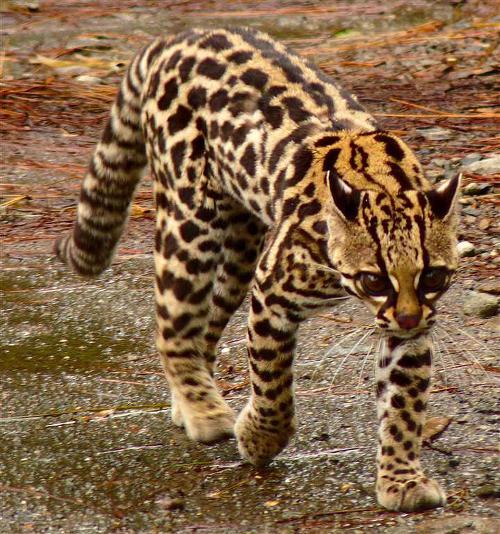 Ocelot EcuadorPhoto: Geigi in the public domain
Ocelot EcuadorPhoto: Geigi in the public domain
Well-known mammals from the rainforests include jaguar, ocelot, puma, armadillo, agouti, sloth, peccary wine, tapir and the rare freshwater dolphin. Furthermore many species of monkeys such as howler monkeys, spider monkeys, wool monkeys, capuchin monkeys and marmosets. Many macaw species, hummingbirds and toucans are common appearances. Notable appearances are the three-toed and two-toed sloth. Rare is the harpy eagle. Waterfowl such as bitterns, ibises, storks and a huge variety of herons are also well known. The amioema is a species of goose that can grow up to 1 meter.
Reptiles are often not visible but are abundant: ao black caiman with a length of 5-6 meters, the spectacled caiman, turtles and lizards . The boa constrictor and the impressive anaconda (up to nine meters long) are dangerous constrictors. The fer-de-lance or lance point snake is highly poisonous. The brightly colored poison dart frogs are known for the poison used by the Indians for their blow darts.
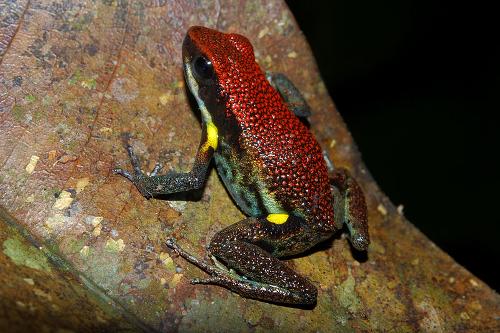 Poison dart frogs EcuadorPhoto:Geoff Gallice CC 2.0 Generic no changes made
Poison dart frogs EcuadorPhoto:Geoff Gallice CC 2.0 Generic no changes made
Of the countless insects, the most beautiful are the butterflies (about 4500 species): the bright blue morpho has wings with a wingspan of 18 cm. The tarantula kills its prey with poison, but is the only dangerous spider in the Ecuadorian jungle. A special spectacle are the enormous columns of leaf-cutting parasol ants, whose females constantly walk to the nest with a piece of leaf. Meter-high termite mounds house termite states with a king, queen, workers and soldiers. Mosquitoes are very difficult animals for humans, and the malaria mosquito can be very dangerous for humans.
Research has shown that there are approximately 3000 species of beetles and beetles at five different locations in the rainforest. However, these pitches were no larger than 12m2 !! A recent inventory of fish species in Ecuador yielded more than 1000 species. The electric eel can produce 600 volt electric shocks. Schools of piranhas can also be dangerous and the stingray is also poisonous.
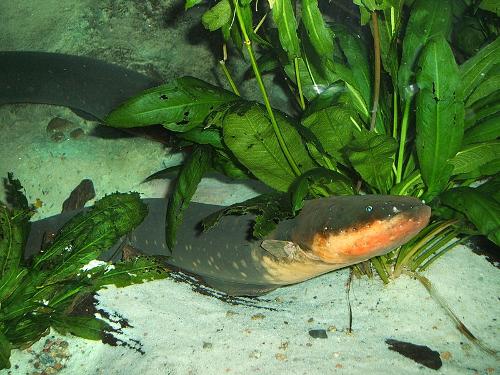 Electric Eel EcuadorPhoto: Steven G Johnson CC 3.0 Unported no changes made
Electric Eel EcuadorPhoto: Steven G Johnson CC 3.0 Unported no changes made
The cloud forests on the slopes of the Andes are between 1000 and 3500 meters. Here there is very high humidity and trees of the mountain forests, including quiñua and quishuar, are covered with mosses, tree ferns, epyphites (non-parasitic host plant), orchids and bromeliads.
The number of species of animals is many less than in the rainforest and are also less impressive. Commonly, otter, armadillo, tree anteater, opossum, skunk and agouti and bats (more than 100 species) occur. The spectacled bear is very rare. Colorful birds are tangaras (about 133 species in Ecuador) and hummingbirds (about 120 species). Amphibians are mainly represented by many frog speciesch feel at home in this humid environment.
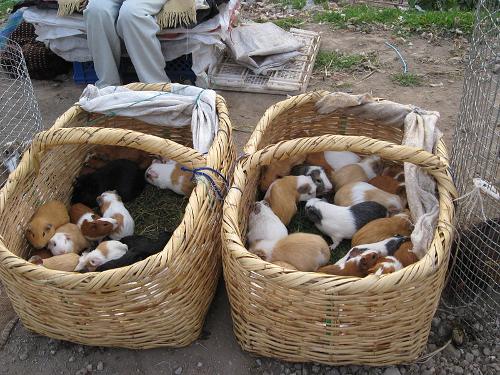 Guinea pigs on the market in EcuadorPhoto:Chris Fraser CC 2.0 Generic no changes made
Guinea pigs on the market in EcuadorPhoto:Chris Fraser CC 2.0 Generic no changes made
Above 3500 meters lies the paramo area (approx. 10% of the total area of Ecuador) with mostly grasses, shrubs and shrubby trees, the remains of the Andes forest. Special is the "frailejon" or espeletia, a giant gemweiss that can reach a height of up to two meters. Another special plant is the medicinal chuquiragua.
Obviously the greater the height, the fewer animal species occur. The paramos are mainly used by the Indians to pasture the cattle. Several species of small marmotids are hunted by the fox-like paramocoyote. Well-known is of course the Guinea piglet or the "cuy" as it is called in Ecuador. They occur in the wild but are also bred for their meat.
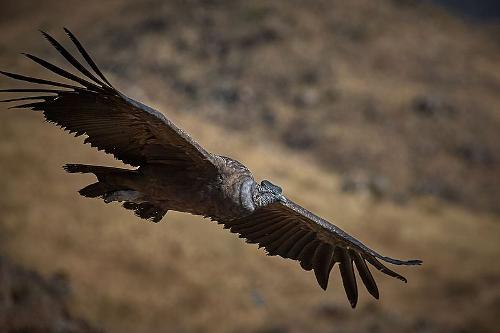 Andean Condor EcuadorPhoto: Pedro Szekely CC 2.0 Generic no changes made
Andean Condor EcuadorPhoto: Pedro Szekely CC 2.0 Generic no changes made
The largest bird in the world with a wingspan of about three meters is the Andean condor which sometimes flies at an altitude of 6000 meters, higher than any other bird in the world. However, this gigantic bird is seriously threatened with extinction; probably there are only a few hundred pairs left. Other notable birds in this area are the caracara and the Andean lapwing.
Savannas are found in the central and southern coastal area. Originally covered with forest, this area has been deforested by human hands and turned into savannah. Here too, the giant kapok trees and a large number of shrubs and herbs grow. Remarkable is the "ceibo", a tree with a trunk in the shape of a bottle. The savannas do not have a rich animal life either. Snakes and lizard species are common, along with some small mammals. Black vulture and turkey vulture circle the air.
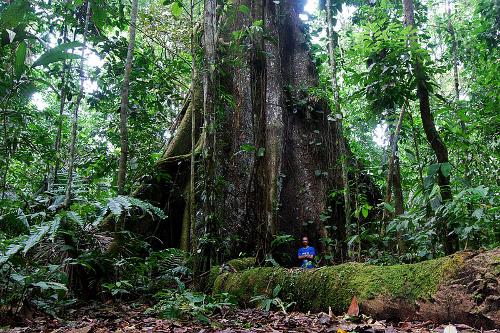 Ceibo EcuadorPhoto: Geoff Gallice CC 2.0 Generic no changes made
Ceibo EcuadorPhoto: Geoff Gallice CC 2.0 Generic no changes made
In the desert-like coastal region, vegetation is limited to grasses and many types of cacti.
Mangroves with their typical stilt and breath roots grow in brackish water of tidal areas. Ecuador's mangrove forests are under severe threat from shrimp farming, which means that they are currently largely cleared. The red mangrove is the best known species in Ecuador.
The mangrove forests are home to many species of seabirds such as spoonbills, cormorants, frigate birds, snake-necked birds and brown pelicans. Many fish, molluscs, crustaceans and shellfish also have their habitat here.
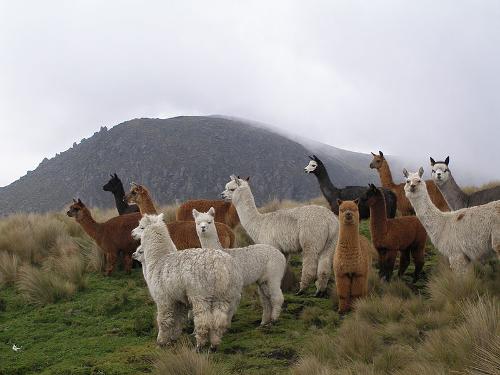 Alpacas EcuadorPhoto: Philippe Lavoie in thepublic domain
Alpacas EcuadorPhoto: Philippe Lavoie in thepublic domain
Of the cultivated crops, the potato and the yucca are the most important. There are over 200 wild varieties and nine varieties of cultivated potatoes. There are two types of yucca: bitter and sweet. Corn is also a plant that has been important as food for the indigenous population for thousands of years. There are about 50 species in the Andes.
Kinini, the medicine against malaria, was discovered in Ecuador in the 17th century. The medicine is made from the powder of the bark of the quina tree. Due to the high demand for the drug, the quina forests quickly disappeared, which meant the end of the quina culture in Ecuador.
The most famous group of animals of the Andean mountains are the camelids: the guanaco, the vicuña , the alpaca and the llama. The guanaco and the vicuña live in the wild, the llama and the alpaca are domesticated. They are used as pack animals and for meat and wool. The guanaco is almost extinct in Ecuador and the vicuña is threatened with extinction. By protecting both species, the hope is to preserve the species in Ecuador.
Sources
Ecuador
Cambium
Luft, A. / Reishandboek Ecuador en de Galápagoseilanden
Elmar,
Rachowiecki, R. / Ecuador & the Galápagos islands
Lonely Planet
Renterghem, O. van / Ecuador : mensen, politiek, economie, cultuur
Koninklijk Instituut voor de Tropen/Novib
Vries, W. de / Ecuador, Galápagos
Gottmer
CIA - World Factbook
BBC - Country Profiles
Copyright: Team The World of Info